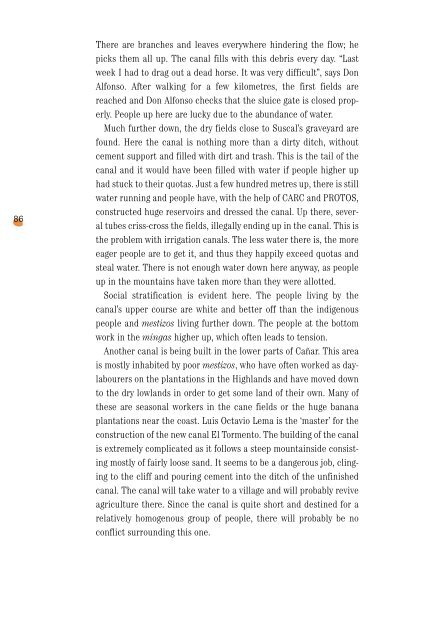mishqui-yacu, sweet water - IFAD
mishqui-yacu, sweet water - IFAD
mishqui-yacu, sweet water - IFAD
You also want an ePaper? Increase the reach of your titles
YUMPU automatically turns print PDFs into web optimized ePapers that Google loves.
86<br />
There are branches and leaves everywhere hindering the flow; he<br />
picks them all up. The canal fills with this debris every day. “Last<br />
week I had to drag out a dead horse. It was very difficult”, says Don<br />
Alfonso. After walking for a few kilometres, the first fields are<br />
reached and Don Alfonso checks that the sluice gate is closed properly.<br />
People up here are lucky due to the abundance of <strong>water</strong>.<br />
Much further down, the dry fields close to Suscal’s graveyard are<br />
found. Here the canal is nothing more than a dirty ditch, without<br />
cement support and filled with dirt and trash. This is the tail of the<br />
canal and it would have been filled with <strong>water</strong> if people higher up<br />
had stuck to their quotas. Just a few hundred metres up, there is still<br />
<strong>water</strong> running and people have, with the help of CARC and PROTOS,<br />
constructed huge reservoirs and dressed the canal. Up there, several<br />
tubes criss-cross the fields, illegally ending up in the canal. This is<br />
the problem with irrigation canals. The less <strong>water</strong> there is, the more<br />
eager people are to get it, and thus they happily exceed quotas and<br />
steal <strong>water</strong>. There is not enough <strong>water</strong> down here anyway, as people<br />
up in the mountains have taken more than they were allotted.<br />
Social stratification is evident here. The people living by the<br />
canal’s upper course are white and better off than the indigenous<br />
people and mestizos living further down. The people at the bottom<br />
work in the mingas higher up, which often leads to tension.<br />
Another canal is being built in the lower parts of Cañar. This area<br />
is mostly inhabited by poor mestizos, who have often worked as daylabourers<br />
on the plantations in the Highlands and have moved down<br />
to the dry lowlands in order to get some land of their own. Many of<br />
these are seasonal workers in the cane fields or the huge banana<br />
plantations near the coast. Luis Octavio Lema is the ‘master’ for the<br />
construction of the new canal El Tormento. The building of the canal<br />
is extremely complicated as it follows a steep mountainside consisting<br />
mostly of fairly loose sand. It seems to be a dangerous job, clinging<br />
to the cliff and pouring cement into the ditch of the unfinished<br />
canal. The canal will take <strong>water</strong> to a village and will probably revive<br />
agriculture there. Since the canal is quite short and destined for a<br />
relatively homogenous group of people, there will probably be no<br />
conflict surrounding this one.
















